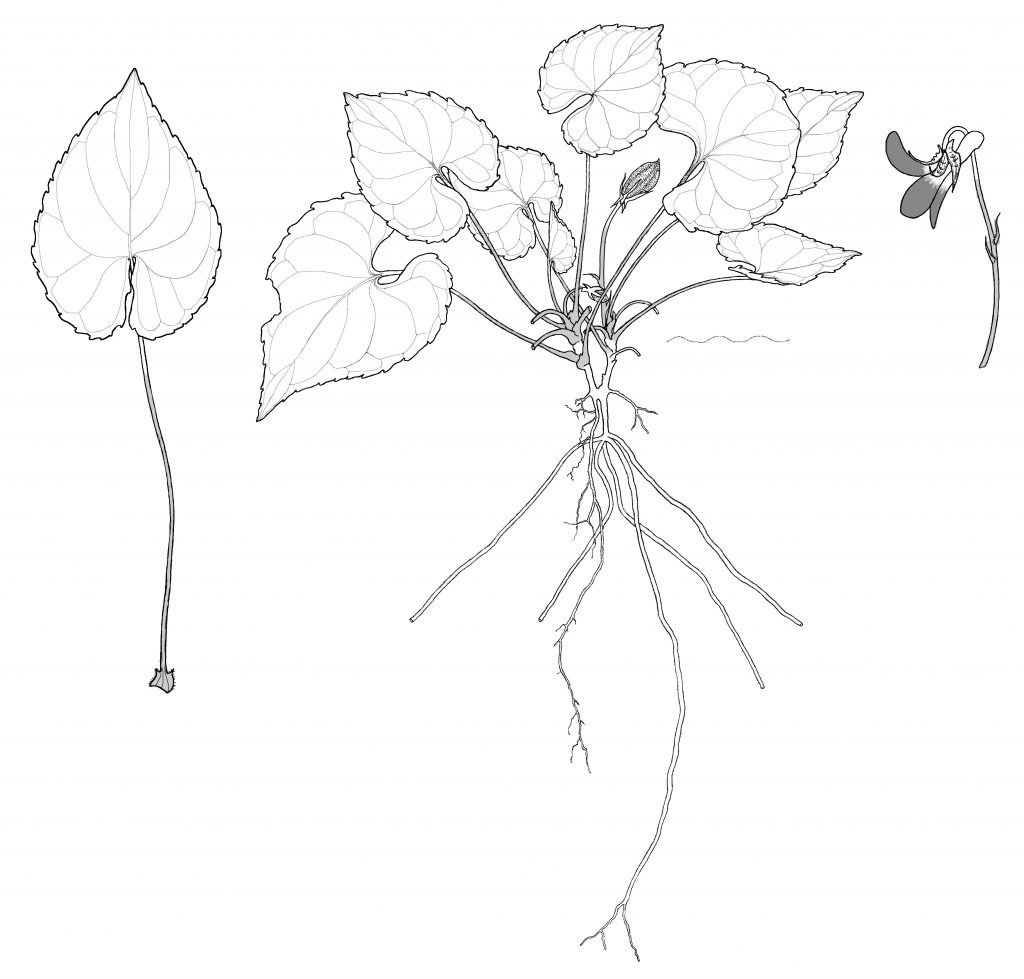Viola selkirkii. Pursh ex Goldie
Description and illustrations: 4 photographs and 3 drawings of Viola selkirkii

This species is the sole North American representative of a predominantly Eurasian group of approximately two dozen species, all characterized by distinctly adnate stipules at the base of the petiole. This feature separates Viola selkirkii from all other blue-flowered stemless violets in North America, with the exception of Viola pedata, but though the latter also has adnate stipules, it is visually and taxonomically distinct in many other ways from all other violets. Viola selkirkii is closer to the stoloniferous Palustres group that have similar style heads and similarly colored flowers.
V.selkirkii is a circumpolar species that probably originated in the Old World, and may have spread to North America across the Atlantic from southwest Greenland or from eastern Asia. It is present in Scandinavia, Europe, Russia, China, and Japan. In spite of its wide range, it does not separate into geological races. Although this species is reported as being rare, this may be partly because it flowers before most observers are in the field.
Diagnostic characteristics of this species are:
- very early flowering time, before all other violets
- scarcity, even in its cold boreal habitat
- calcareous locations
- open lilac-colored flowers with a white center
- long blunt petal spur, 6 mm long
- large, regular, saw-teeth on the margins of the heart-shaped leaves
- for most of their length stipules adnate to the base of the petiole.

This floriferous small violet does not grow larger in the summer, though its outer leaves spread horizontally, occasionally lying flat on the ground. The vertical rhizome is white, slender, 1-2 mm thick, with long, relatively thick roots. Viola selkirkii often produces adventitious shoots from its roots, but it remains a stemless violet.
The pointed heart-shaped leaves are light green and thin-textured, their translucence highlighting the purple veins and purple edges to the leaves. Long leaf bases either form a deep narrow sinus or overlap at their inside edges. The upper surface of the leaf is scattered with minute stiff hairs, particularly near the margin, while the lower surface is glabrous. The pubescent leaf margin continues down the petiole to make it narrowly-winged at the top; petiole purple.
Peduncles are short, glabrous, and tinged with purple; bracteoles of the same color are 0.5 cm long, at or below the mid-point. The flowers are relatively large, 1.9-2.0 cm wide; the petals lilac with a white center; petals beardless. All petals have light veining, the three lower petals with darker violet veining; the ovary is green spotted with purple, glabrous. The prominent petal spur is 5–7 mm long, thick and rounded at the end. The calyx is purple, 0.7-0.8 cm; sepals glabrous, lanceolate; appendages over 1mm long, flaring out from the peduncle, a few very short hairs on the margin. Flowering May-July.

Seed pods, both open and closed, are borne on erect purple peduncles, the capsules are elliptical to globose, green with dark purple spots and glabrous, 4–8 mm long. Pale brown seeds measure 1.5-2.0 x 1.0-1.2 mm. A delicacy for slugs.
Viola selkirkii is found in the shade of cool boreal mountain forests. It grows in rich moist soils, frequently on rotting logs, in moss on limestone rocks and ledges or beside cool creeks. Its prefered habitat is evergreen and hardwood forests, particularly under hemlocks, pine, spruce and alders.
It occurs discontinuously in North America from Labrador, Newfoundland, Nova Scotia, western Ontario and Quebec across southern Canada to southern Alaska, British Columbia, the Yukon Territory and Washington State. In the east it spreads to New England, New York state, Minnesota, north eastern Wisconsin, central Michigan and northern Ohio. It also occurs infrequently in the northern Rocky Mountain range south to Colorado where it is recorded at only two locations: Devil’s Head, in Douglas County, and in the Rocky Mountains National Park at 8,700 feet. Here it used to grow in association with Viola renifolia but the policy of the park to protect the local antelope population, has been to the detriment of the delicate balance of this plant community. Viola selkirkii may be extinct in NE Pennsylvania though Russell (1956) reported it as locally abundant in eastern New York state. There is a disjunct and scarce population in the Black Hills of southwest South Dakota.



Taxonomy and Nomenclature:
V. selkirkii Pursch ex Goldie, Edinb. Phil. Jour. 6: 324, 1822, (syn. Viola umbrosa Fries Novit. 271).
Section Plagiostigma subsection Estolonosae (Marcussen, new classification, 2011).
Violidium Group?.
2N=4x=24.
John Goldie (1793-1886) collected specimens around the Great Lakes and Montreal areas in 1819-23. Goldie’s violet was named by Frederick Pursh (1771-1820) in honor of Thomas Douglas, Earl of Selkirk, (1771-1820), a member of the Royal Society, who was active from 1803 to 1816 in settling poor Scottish highlanders into farming colonies in Eastern Canada.